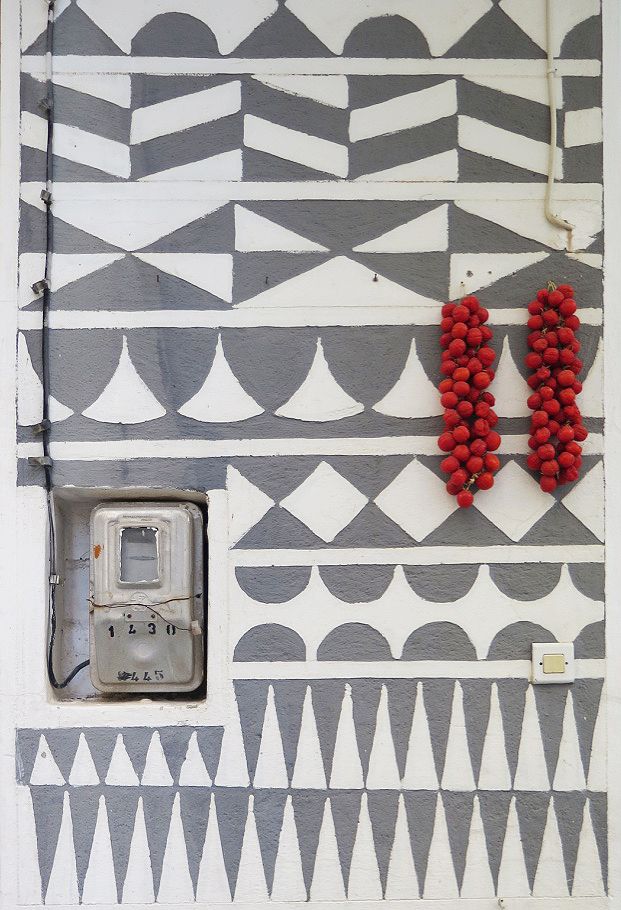Video courtesy of the Athens Biennale, 2021. Direction: Nysos Vasilopoulos Filming and editing: Alekos & Christos Mpourelias Music: ILIOS
About the project
TA NEA XYSTA (THE NEW SCRATCHES), 2021 is a site-specific mural that created a portal for the Santaroza building of the Athens Biennale 7-Eclipse. Painted by hand in metallic grey and white by the artist andthree female assistants, the mural replays and responds to the traditionaldesign work known as “xysta”, originating from a village on the island ofChios in Greece. This ethno-mathematical painting often resembles a textile; Dossos explains the work should be read as such, noting that at thebottom of the mural one can often find tassels and tapered edges.
The origins of this practice of painting the exterior walls of houses in this village sit between East and West. According to various origin stories, during the Genoese period of occupation, textiles were often hung from balcony windows, and the lavish designs became the inspiration for the walls. According to a different version of their beginnings, this tradition is rooted in Turkish pattern-making and decor. Dossos revives the xysta mural practice, allowing it to breathe between these insignia – adding a technological universality to the palette, and offering the viewer lines of code that are in constant dialogue with one another. You can find the Twitter bluebird insignia gliding between the geometrical fauna; a reference to the symbol of an eclipse – the theme for this Biennale, can be found in two circles shifting between each other (also used online as a transparency symbol); the eerie Covid-19 icon drifts in between, allowing us to reflect on this moment through the lens of the contemporary rhizome.
The artist was supported by Beowulf/ rossogranada
Commissioned and produced by the Athens Biennale.
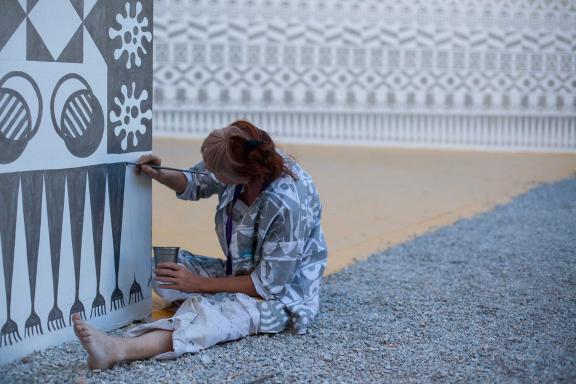
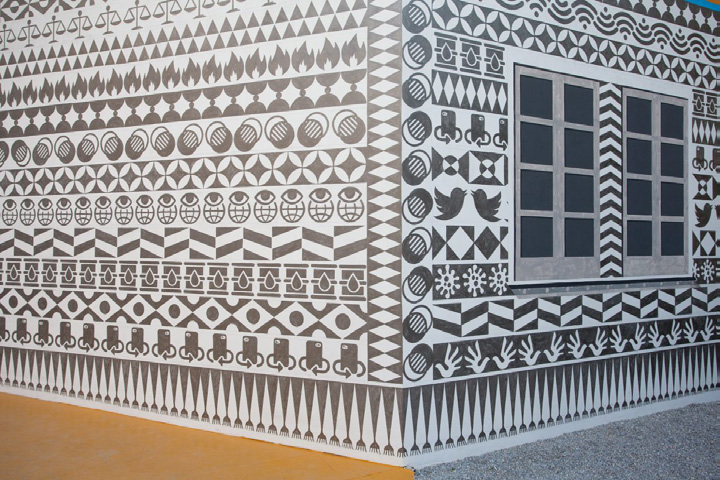
About the artist
Navine G. Dossos (b. 1982, London) is a visual artist working between London and Athens. Her interests include Orientalism in the digital realm, geometry as information and decoration, image calibration, and Aniconism in contemporary culture. She has developed a form of geometric abstraction that merges traditional Aniconism of Islamic art with the algorithmic nature of the interconnected world we live in. This is not the formal abstraction we understand from the western history of art, but something essentially informational, and committed to investigation and communication.
Dossos studied History of Art at Cambridge University, Arabic at Kuwait University, Islamic Art at the Prince’s School of Traditional Art in London, and holds an MA in Fine Art from Chelsea College of Art & Design.
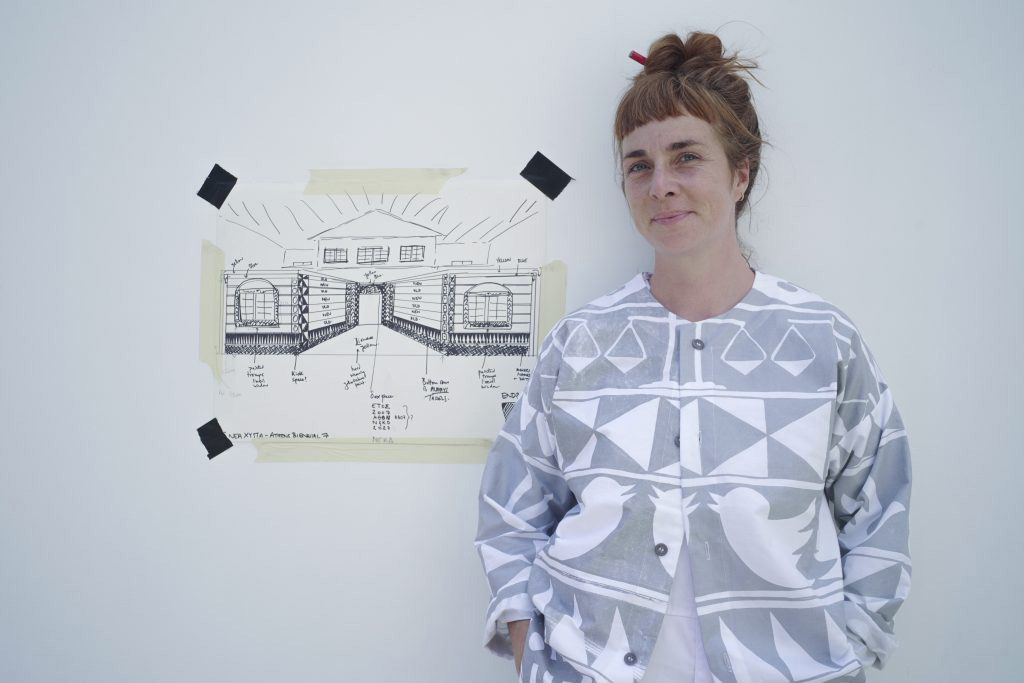
Exclusive interview
BEOWULF / rossogranada in conversation with
Navine G. Dossos
British artist Navine G. Khan-Dossos, in conversation with our Director, Xanthi Skoulariki, over her participation in the 7th Athens Biennial that took place from September 24th to November 28th 2021 in the capital of Greece that is also the city where Navine resides.
Khan-Dossos studied History of Art at Cambridge University, Arabic at Kuwait University, Islamic Art at the Prince’s School of Traditional Art in London, and holds an MA in Fine Art from Chelsea College of Art & Design, London. In 2014/2015, she was a participant at the Van Eyck Academie in Maastricht (NL). She has exhibited and worked with various institutions, including Showroom (London), Z33 (Hasselt), The 4th Istanbul Design Biennial, SALT (Istanbul), The Taipei Biennial, Capital of Culture (Matera), The Van Abbemuseum (Eindhoven), Witte de With (Rotterdam), The Delfina Foundation (London), The Museum of Islamic Art (Doha), Leighton House Museum (London), The Benaki Museum of Islamic Art (Athens) and the A.M. Qattan Foundation (Ramallah).
The artist is supported by Beowulf.
Your participation at Eclipse – the title of the 7th Athens Biennale – is with a site-specific work titled in Greek Ta Nea Xysta (Τα Νέα Ξυστά), inspired by a research trip on the island of Chios on the Aegean sea. Tell us a bit about the role of ‘tradition’ in your work.
I have always been interested in how traditional art forms continue to have meaning as a visual language, and how parts of that language might also become more abstract to us. On Chios, I visited the village of Pyrgi, also known as the ‘painted village’, which is known for its monochrome geometric designs on the house-fronts on every street. Looking at these patterns I couldn’t help but wonder what information these designs contained and what they may have signified to the owners of these homes when they were created. In my own work I like to take up these ideas, playing with the original traditional art-form, and updating it for a contemporary audience.
You have produced ‘itinerant’ art for and in various culturally diverse geographies such as Istanbul, Sofia, the Azores and you recently visited Uzbekistan. As you open up to new challenges, are there any recurring intellectual preoccupations that permeate your art through time and space?
Being able to travel and create site-specific commissions is a great privilege for me as an artist. It is always fascinating to step into a new context that was perhaps a previously unknown culture to me and to find aspects of it that connect to my own interests and ways of working. It is always a challenge to make work that is sensitive and meaningful to the location of the project, but these are factors that drive my work and keep it relevant and flexible. And this can only be done with careful research, many conversations at a local level, and finding ways to collaborate that are exciting and joyful for all involved!
Everything starts with… an idea in the middle of the night, just when I should be falling asleep.
As an outspoken artist on urgent matters such as social injustice, terrorism and politics, you paint with encoded vocabularies, often with a message hiding in plain sight. What attracts you in this juxtaposition?
Visual art has always been a critical space for difficult ideas to be worked through and shared. I think of my work as a space for me to connect with issues that concern me, and to try to present these subjects to the viewer through my own language. I try to create works that are meditations on the subject rather than direct and confrontational visualisations of often already familiar topics. That way, the person in front of the work is able to pause for a moment and consider their own relationship to that subject without the violence of difficult politics repelling them before they have time to reflect.
Speaking of unexpected contrasts and hidden messages, you have developed a very personal combination of enveloping the digital element into your clearly painterly approach to making art. Why do you feel the need for doing so?
Painting is a very important response to the digital world. We don’t need to only use pixels to represent this electronic space! We can use all kinds of mediums – and for me water-based paints are a particularly valuable material parallel. We can talk about transparency, the thinness of surface, the ephemeral nature of the rapidly changing screen. Water-based paints also allow me to respond very quickly to new events and stories without having to wait long periods of time for the paint to dry, as we might experience with oil paint. So, painting is about time and presence and process for me. And these are all things that are also there to be investigated in our relationship to the digital world too.
And so, when Ta Nea Xysta came to existence in September in Athens and following the prolonged seclusion the pandemic has brought about on us all, what did you hope the audience connected with?
It was a great pleasure for me to make a public-facing work in Athens. It was also be my first large-scale mural since the pandemic started. What I hope for the work is that it approached with a mixture of familiarity (as the designs from Chios are well known and recognised by many in Greece) and curiosity. I hope viewers enjoyed unpicking the symbols of the work, saw what parts they recognise as part of their own day-to-day visual vocabulary and deciphered what messages these symbols might carry in the context of this work but also the wider context of the Biennial.
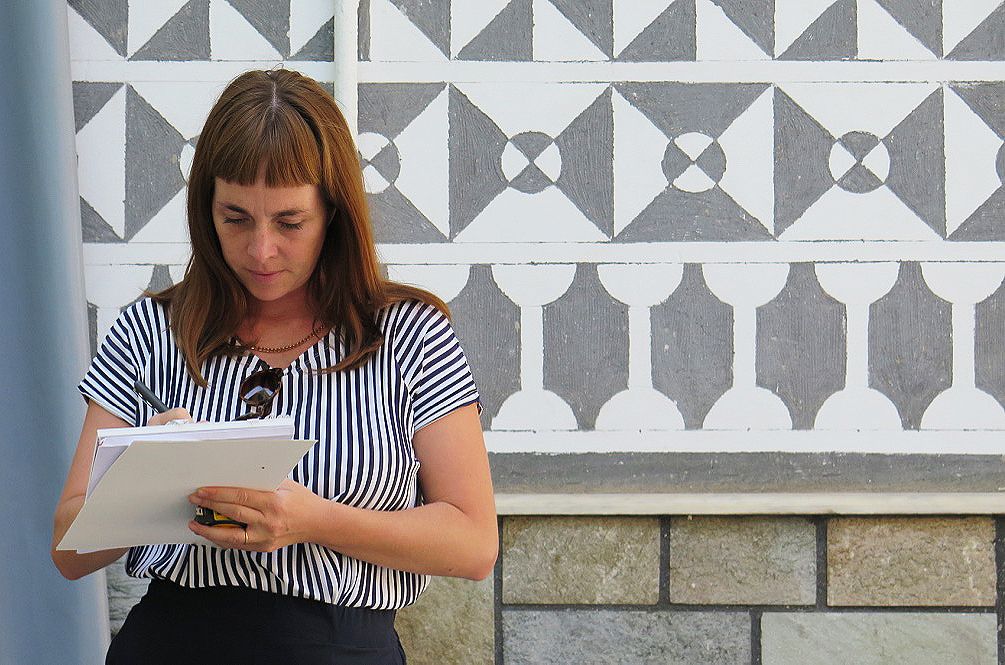
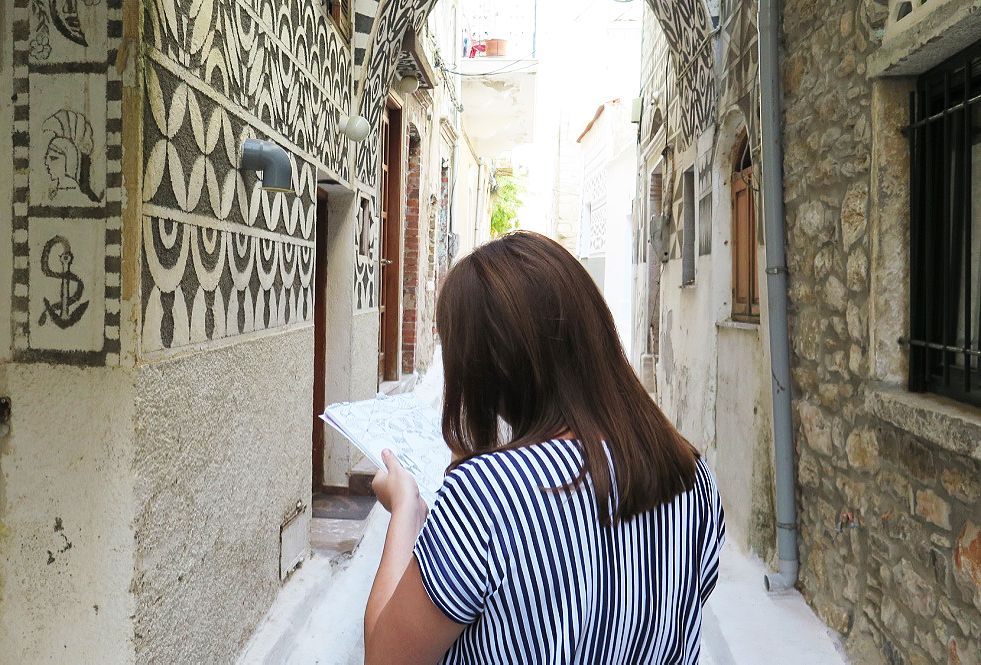
カンバセーション
英国のアーティスト、ナヴィーヌ・カーン=ドソスと、ベオウルフのディレクター、クサンティ・スコウラリキが、ナヴィーヌが暮らすギリシャの首都で2021年9月から11月に開催されるアテネ・ビエンナーレへの参加について対話しました。
ナヴィーヌはケンブリッジ大学で美術史を、クウェート大学でアラビア語を、ロンドンのプリンス・スクール・オブ・トラディショナル・アートでイスラム美術を学び、ロンドンのチェルシー・カレッジ・オブ・アート・アンド・デザインで美術の修士を取得しました。2014年から15年にはマーストリヒト(オランダ)のヤン・ファン・エイク・アカデミーに参加しています。彼女は様々な機関で作品の展示や制作をしてきており、Showroom(ロンドイン)、Z33(ハッセルト)、第4回イスタンブール・デザイン・ビエンナーレ、SALT(イスタンブール)、台北ビエンナーレ、Capital of Culture(マテーラ)、ファン・アッベ美術館(アイントホーフェン)、ヴィッテ・デ・ヴィット現代美術センター(ロッテルダム)、デルフィナ財団(ロンドン)、イスラム美術館(ドーハ)、レイトンハウス博物館(ロンドン)、ベナキ・イスラム美術博物館(アテネ)、そしてA.M.カタン財団(ラマッラ)などが挙げられます。
ベオウルフはこのアーティストを支援しています。
アテネ・ビエンナーレにはギリシャ語の「Ta Nea Xysta(タ・ネア・クシスタ、新しい傷)」というタイトルのサイト・スペシフィックな作品で参加しますね。エーゲ海のキオス島への視察でヒントを得たとのことですが、あなたの作品における「伝統」の役割についてお話いただけますか。
伝統的な芸術様式がいかに視覚言語として意味を持ち続けるか、そしてその言語の一部がいかに抽象的になり得るかということに常に興味を持っていました。キオス島ではピルギ村を訪れましたが、ここは「ペインティッド・ヴィレッジ」としても知られ、あらゆる通りの家の正面にモノクロームの幾何学デザインが施されています。それらを見ていると、この意匠にはどういう情報が込められていて、家が建てられたときに家主にとってどんな意味があったのかと考えずにはいられませんでした。私の作品ではこれらのアイディアを取り入れて、もとの伝統的な芸術様式を応用し、現代のオーディエンス向けにアップデートしたいと考えました
あなたはイスタンブール、ソフィア、アゾレス諸島、そして最近訪れたウズベキスタンなど、文化的に多様な色々な地域のために、またそれら地域において「旅する」アートを制作してきました。新たな挑戦に取り組むとき、時間や空間を超えて作品に常に浸透している知的関心事はありますか?
旅をしてサイト・スペシフィックなコミッション作品を制作できることは、アーティストの私にとって大きな恩恵です。それまで知らなかったであろう新たな文化圏に足を踏み入れ、自分の興味や作品制作との接点を見出すことには、いつも魅力を感じます。プロジェクトの土地に配慮しながら、その土地にとって意味がある作品を制作するのは、常にチャレンジです。しかしこうしたことが私の制作の原動力となり、作品を今日的且つ柔軟なものにしています。これは入念な調査や現地での沢山の対話を通じて、関わる全ての人にとってエキサイティングで楽しい協業のあり方を追究することによってのみ、実現するのです。
全ては、眠りに落ちていく夜中のアイディアから始まる
あなたは社会の不正、テロ、政治といった喫緊の課題に声を上げるアーティストとして、暗号化された言葉を描き、見える場所にメッセージを隠すことをよくなさいますね。どうしてこのようなアプローチを取るのですか?
ヴィジュアル・アートは常に、作品化して共有することが難しいアイディアにとって重要な場となっていました。私は自分の作品を、私が関心を持っている課題とつながり、それらの課題を私の言語で鑑賞者に提示する場と捉えています。既によく知られているかもしれないトピックを直接的且つ敵対的に視覚化するのではなく、課題を沈思黙考するための作品を心がけています。そうすることで、作品の前にいる人は一瞬立ち止まることができ、難しい政治の暴力に嫌悪感を抱く前に、自分自身と課題との関係を考えることができます。
予期せぬコントラストや隠されたメッセージについてですが、あなたはご自身のとても絵画的な作品制作のアプローチにデジタルな要素を取り入れる、非常にパーソナルなコンビネーションを開発しました。なぜそうする必要があると感じたのですか?
ペインティングはデジタル世界に対するとても重要な答えです。私たちはこの電子的な世界をピクセルだけで表現する必要はありません。どんな媒体でも利用できます。私にとって水性塗料は特に価値がある類似素材です。透明性、表面の薄さ、素早く変化する画面のつかの間の性質などが挙げられます。また水性塗料は油性塗料と違って乾くのを長い間待つ必要がないので、新しい出来事やストーリーに素早く対応できます。私にとってペインティングは時間と存在、そしてプロセスなのです。これらの事は全て、私たちとデジタル世界との関係においても考慮されるべきことです。
「Ta Nea Xysta」は、我々が皆パンデミックによる長期間の隔離を経験した後、9月にアテネで公開されますが、オーディエンスにはどんなことを感じて欲しいですか?
アテネでパブリックに展示される作品を制作できることは大きな喜びです。私にとってはパンデミック前を含めても初めての大型壁画です。作品は、様々なレベルの親しみやすさ(ギリシャの多くの人にとってキオス島の意匠はよく知られているので)と好奇心を持って見ていただきたいです。また見る人が作品のシンボルを読み解いたり、自分の日常の視覚言語として認識できる部分を見つけたりして、作品の中で、そしてビエンナーレという幅広い文脈のなかで、シンボルがどういう意味を持ち得るのか解読するのを楽しんでくれることを願っています。
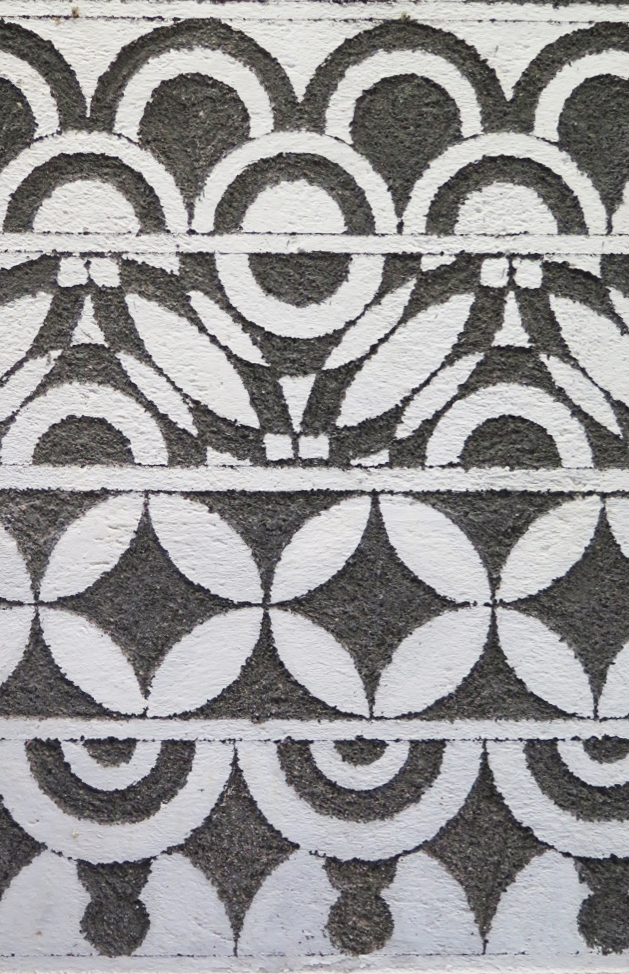
Detail of the Xysta style, Chios Island, Greece. Courtesy of the artist.
